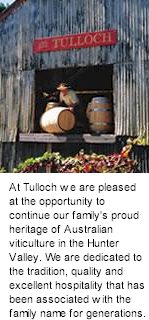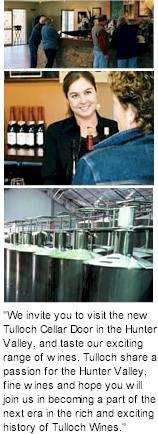


In 1895, Jame's grandson, John Younie Tulloch (J.Y. Tulloch) owned the Branxton General Store and accepted an unusual settlement for a debt owed to him - a 43 acre property in nearby Pokolbin. Tulloch took an immediate liking to the property and the five acres of neglected Shiraz vines it contained and undertook his first foray into viticulture and winemaking, which began the family tradition.

By the 1920's J.Y. Tulloch had established himself as the largest vigneron in the Hunter Valley and began a tradition of quality and excellence that is now synonymous with the Tulloch name. Hector Tulloch took over the reins of the family company, and was integral in bringing the family name to prominence throughout the 1950's when he developed the famous Pokolbin Dry Red and Hunter River White labels. Hector's legacy lives on in the Australian wine industry as a pioneering Hunter Valley winemaker.
In 1969 J.Y. Tulloch & Sons P/L was sold outside of the family for the first time to Reed Consolidated Publishing. In 1973 Jay Tulloch became General Manager and 50% of the company was sold from Reeds to Gilbey's Australia. From this point on mutliple ownerships changes occured as the company passed from Gilbey's to Castlemaine Tooheys to Penfolds, which was eventually sold to SA Brewing in 1992 and renamed Southcorp Wines.
By 1996 Jay Tulloch remained as General Manager of Southcorp's Hunter Valley operations, which included Hungerford Hill and another old Hunter name, Lindeman's Wines, as well as Tulloch. Jay retired form Southcorp in 1996 and in 1997 he and his wife, Julia Tulloch, started their own boutique operation, the JYT Wine Company. Under the direction of Jay and Julia Tulloch, the JYT Wine Company was founded in 1997 and gave Jay the opportunity to produce premium quality wines from his own small vineyard in the approachable style that had become his trademark.

In 2001 the opportunity arose to buy back the old family company, J.Y. Tulloch & Sons P/L from Southcorp Wines. Unable to resist and with interest from long term friends and business associates Inglewood Vineyards the new era of J.Y. Tulloch & Sons began, with a Tulloch once again at it's helm and its commitment to quality Hunter Valley wines renewed.
A respected member of the Australian wine industry, Jay Tulloch has continued his family's proud tradition of viticulture and has contributed enormously to the shaping of the Hunter region along the way. Now his youngest daughter Christina joins him as the Operations Manager of the new cellar door which opened in December 2003.
Distribution through Angove's Wines, also a family owned business, ensures the unique historical tradition of the brand is preserved while allowing commercial viability to be explored. One of the Hunter's great winemaking names lives on with Tulloch and the job of producing approachable wines for all generations of wine drinkers continues.
Still located in Pokolbin's viticultural heartland where the story began in 1895, Tulloch remains as the true heritage of the Hunter Valley. Now in its 110th year the Tulloch name lives on as a founding wine producer of the Hunter region, continuing to strive for excellence in the production of premium Hunter varietals and styles. The current Tulloch range, which also features new labels, spans a broad varietal base and completes a portfolio produced from premium Hunter varietals, while mainaining a modest price base and approachable style.
